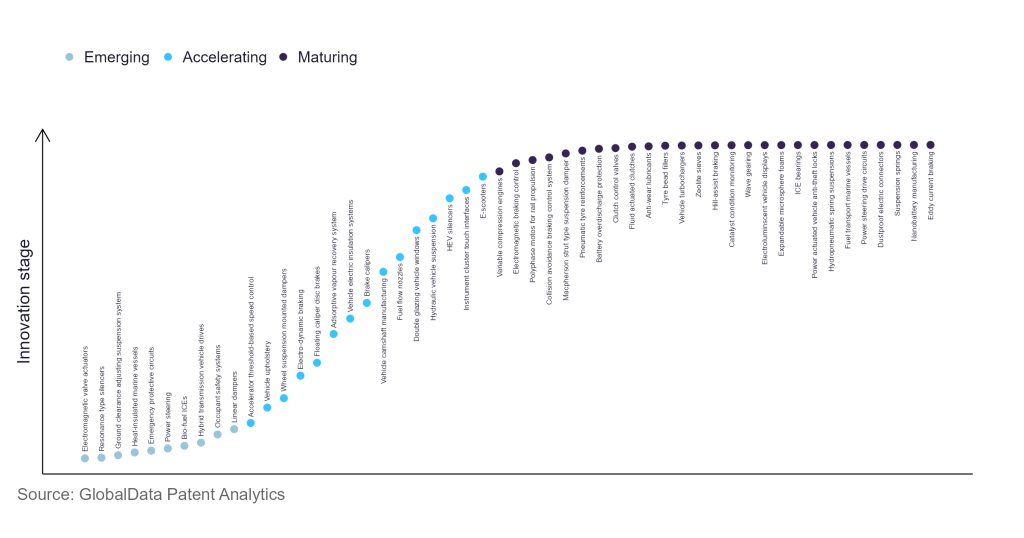The automotive industry continues to be a hotbed of innovation, with activity driven by the demand for battery storage, and emissions regulations, and the growing importance of technologies such as electrification, and connected and autonomous vehicles. In the last three years alone, there have been over 1.2 million patents filed and granted in the automotive industry, according to GlobalData’s report on Innovation in Automotive: Nanobattery manufacturing. Buy the report here.
However, not all innovations are equal and nor do they follow a constant upward trend. Instead, their evolution takes the form of an S-shaped curve that reflects their typical lifecycle from early emergence to accelerating adoption, before finally stabilising and reaching maturity.
Identifying where a particular innovation is on this journey, especially those that are in the emerging and accelerating stages, is essential for understanding their current level of adoption and the likely future trajectory and impact they will have.
290+ innovations will shape the automotive industry
According to GlobalData’s Technology Foresights, which plots the S-curve for the automotive industry using innovation intensity models built on over 619,000 patents, there are 290+ innovation areas that will shape the future of the industry.
Within the emerging innovation stage, resilient spoke wheels, auto-transmission lubrication circuits, and ignition switching engines are disruptive technologies that are in the early stages of application and should be tracked closely. Engine purge actuators, electro-dynamic braking, and adsorptive vapour recovery system estimation are some of the accelerating innovation areas, where adoption has been steadily increasing. Among maturing innovation areas are collision avoidance braking control system and direct injection type engines, which are now well established in the industry.
Innovation S-curve for the automotive industry

Nanobattery manufacturing is a key innovation area in automotive
Nanobatteries are made from particles that are less than 100 nanometres in size using technology at the nanoscale. The batteries can be macroscale or nanoscale and utilise nanotechnology. A macrobattery can be created by combining several nanoscale batteries, as in the case of a nanopore battery.
GlobalData’s analysis also uncovers the companies at the forefront of each innovation area and assesses the potential reach and impact of their patenting activity across different applications and geographies. According to GlobalData, there are 50+ companies, spanning technology vendors, established automotive companies, and up-and-coming start-ups engaged in the development and application of nanobattery manufacturing.
Key players in nanobattery manufacturing – a disruptive innovation in the automotive industry
‘Application diversity’ measures the number of different applications identified for each relevant patent and broadly splits companies into either ‘niche’ or ‘diversified’ innovators.
‘Geographic reach’ refers to the number of different countries each relevant patent is registered in and reflects the breadth of geographic application intended, ranging from ‘global’ to ‘local’.
Patent volumes related to nanobattery manufacturing
Source: GlobalData Patent Analytics
LG is one of the leading innovators in nanobattery manufacturing with 216 filed patents. Honda and LG Chem will form a joint venture to produce nano batteries in the US for the automaker’s forthcoming lineup of electric vehicles (EVs). In early 2023, the two companies began work on the construction of a new manufacturing facility and plan to commence production of nano battery cells by the end of 2025. Other companies innovating in this technology domain are Kia, Hyundai, and Nissan.
To further understand the key themes and technologies disrupting the automotive industry, access GlobalData’s latest thematic research report on Automotive.
Data Insights
From

The gold standard of business intelligence.
Blending expert knowledge with cutting-edge technology, GlobalData’s unrivalled proprietary data will enable you to decode what’s happening in your market. You can make better informed decisions and gain a future-proof advantage over your competitors.



